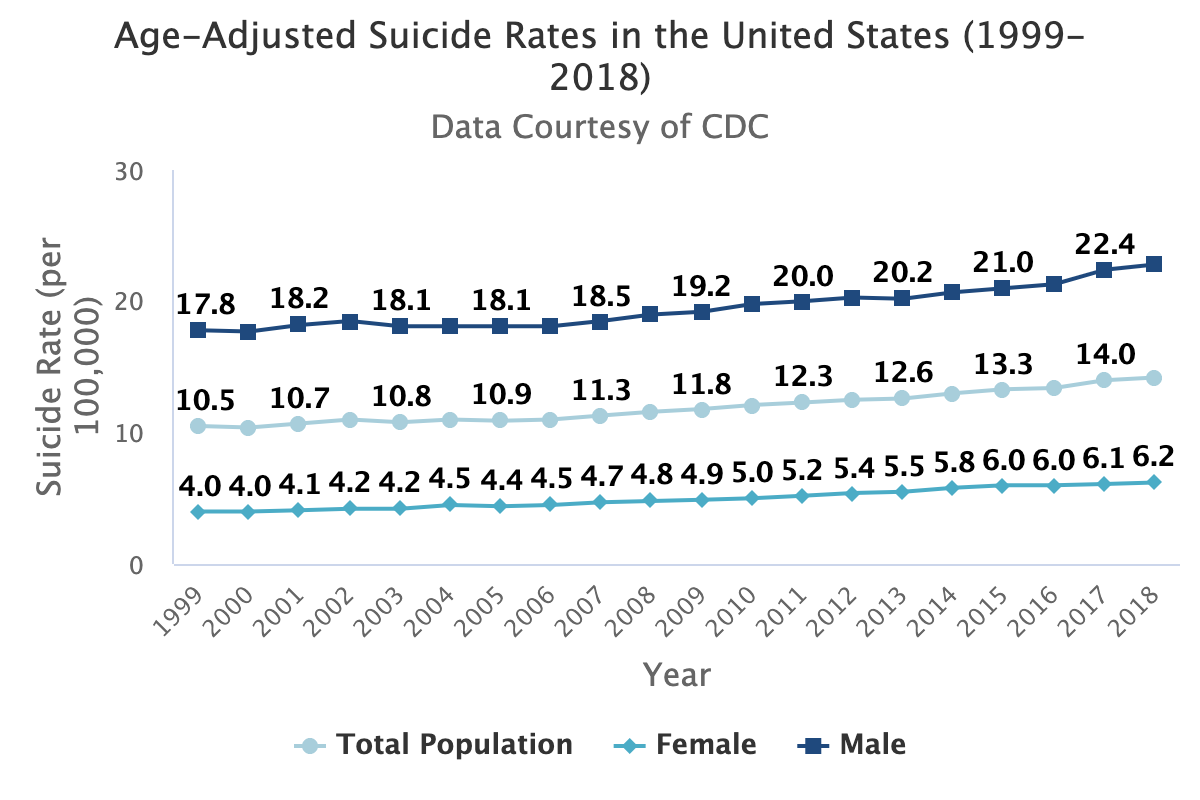Suicide and mental health prevalence

This the first of two blogs addressing suicide and mental health. The seriousness is often not felt in a community unless someone close has attempted suicide or deals with suicidal thoughts. There is a unfathomable emotional toll taken after a suicide and also a heavy economic burden. In this post we will examine the prevalence of suicide in the United States and in Nebraska.
At KCHS we are aware of the pain and prevalence of suicide, suicidal thoughts, and the mental health issues that work as catalysts. Amanda Hall-Warburton, LMHP, CPC, CSW is available for individual, couples, and family counseling. Additionally, Senior Life Solutions is an intensive outpatient group counseling program that assists seniors and older adults. COVID-19 has increased senior isolation and in turn negatively affected seniors. Senior Life Solutions provides relief to seniors and helps them bolster their mental health.
General Statistics in the United States on Suicide

- Suicide is the 10th leading cause for death in the United States
- There is one death by suicide every 12 minutes in the US. That’s 123 Americans each day.
- 45,000 Americans commit suicide annually and the rate of suicide continues to increase.
- 250,000 Americans are estimated to be suicide survivors annually.
- Out of every 25 suicide attempts there is one suicide.
Specifically in Nebraska
- There is one suicide every 36 hours in Nebraska.
- It is the 2nd leading cause of death in ages 15-34.
- It is the 4th leading cause of death in ages 35-54.
- It is estimated suicide cost the Nebraska economy $223,376,000 in 2010a. That is $1,157,386 per suicide.
Suicide affects every community. There is no demographic where the pain and struggle of mental health issues that lead to suicide are felt. Certain people are at more risk than others. Nationalities can play a part. In 2018, American Indians and Whites were more than twice as likely to commit suicide than Asian/Pacific Islanders and Black or African Americans.
In 2017 the Centers for Disease Control released data industry data on suicide. They found that extracting jobs such as mining, quarrying, or oil and gas, construction, services, agriculture, outdoor work, transportation and warehouse work were found to have significantly higher rates of suicide. There are countless ways to break down and view suicides. It affects us all.
Suicide Statistics by Gender
- Most suicides are male. Men make up 79% of all suicides in the US.
- Females are more likely to have suicidal thoughts, experiencing depression at twice the rate of men.
- Women attempt suicide more frequently than men, three times as often.
- Attempts made by women are most commonly poison. Attempts by men are by firearms.

Suicide Statistics by Age
- 1 in 100,000 children between 10-14 commit suicide.
- 7 in 100,000 children between 15-19 commit suicide.
- From ages 15-24 Suicide is the second leading cause of death in Americans
- Ages 18-65 suicide is the fourth leading cause of death.
- Suicide rates for males is highest in 75+ age range at 36 in 100,000.
- Female rates are highest among 45-54 at 9 in 100,000.
- Elderly are most at risk when divorced or widowed.
Suicide Rates by Sexual Orientation and Gender Stats
- Gay, bisexual, and lesbian youths are three times more likely to attempt suicide sometime in their lives. As a whole LGBTQ youths attempt suicide four times as often in their youth.
- In families that reject their LGBTQ child, kids are eight times more likely to attempt suicide.
- Being a victim of abuse, verbal and physical, increases the likelihood that a LGBTQ youth will attempt suicide by 250%.
- 41% of adults that are trans confirm attempting suicide.
Though these statistics can be troubling it is important to know that there is always hope. There are people and resources available to help at any time day or night.
- If you believe someone is in immediate danger call 911
- Suicide Hotline: 800-273-8255
- Counseling at KCHS Amanda Hall-Warburton, LMHP, CPC, CSW
- For older adults at KCHS Senior Life Solutions
Upcoming Events
Health Care Insights
National Radiologic Tech Week-November 3-9, 2024
Celebrating National Radiologic Technology Week: Honoring the Imaging Experts Behind the Scenes Each year, National Radiologic Technology Week shines a spotlight on the essential role that Radiologic Technologists play in healthcare. From November 5th to 11th,...
Diabetes and Your Feet
Diabetes and Your Feet Diabetes is the leading cause of non-traumatic lower extremity amputations in the USA. People with diabetes are at greater risk of complications, such as diabetic neuropathy and peripheral vascular diseases, which can ultimately lead to a foot...
KCHS Wound Care Clinic Encourages Individuals with Diabetes to Prioritize Foot Health, Complete Daily Foot Checks
KCHS Wound Care Clinic Encourages Individuals with Diabetes to Prioritize Foot Health, Complete Daily Foot Checks Center staff observes American Diabetes Month by educating the community on the connection between diabetes and wound care. For most, a blister or cut...
Contact
Address: 727 East 1st Street
Minden, NE 68959
Phone: 308-832-3400
Email: info@kchs.org
Additional Info
